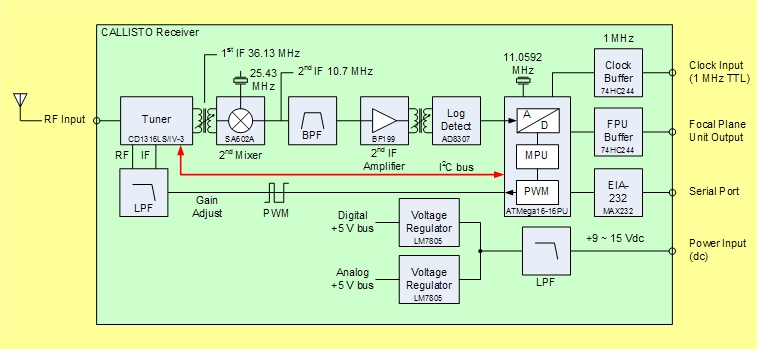e-CALLISTO Solar Spectrometer Network
e-CALLISTO is a worldwide network of frequency-agile solar spectrometers. e-CALLISTO is an acronym for extended Compact Astronomical Low-cost Low-frequency Instrument for Spectroscopy and Transportable Observatory. Callisto is the name of one of Jupiter’s larger moons, and the name also is found in Greek mythology – a nymph of Artemis.
The receiver instrument itself is called CALLISTO. CALLISTO was designed by Christian Monstein at ETH Zurich. CALLISTO can be used in a basic system consisting of the receiver, a linear polarized antenna system and control/logging software. A more advanced system includes a tower-mounted preamplifier or low noise amplifier, additional antennas and a focal plane unit (FPU) with antenna polarization switching and noise calibration capabilities. The receiver and associated software can be setup for linear, right-hand circular polarization (RHCP) or left-hand circular polarization (LHCP) but one receiver is required for each polarization.
The CALLISTO-NA (North America) Receiver is available built and tested. The –NA version incorporates all engineering change requests (ECR) and remedies all non-conformance reports (NCR) through October 2011. The main differences between the North American and ETH versions are panel layout and the dc power input connector.
Click here for information on purchasing a CALLISTO instrument receiver
Click here to view a near real-time spectrogram for Reeve Observatory, Anchorage, Alaska USA
Click here to access observations of e-Callisto, AOS, Argos, Phoenix-3, Phoenix-4
CALLISTO receiver instrument block diagram:

CALLISTO receiver basic specifications:
-
Frequency range: 45 ~ 870 MHz
-
Frequency resolution: 62.5 kHz
-
Intermediate frequencies:
1st IF 36.13 MHz, bandwidth 7 MHz
2nd IF 10.7 MHz, bandwidth 300 kHz -
Observation bandwidth: 300 kHz
-
RF input impedance: 50 ohms
-
Dynamic range: –120 to –10 dBm (typical)
-
Spurious-free dynamic range: 40 dB
-
Noise figure: < 10 dB (typical)
-
Channel sample rate: 800 channels/second (typically 200 channels in 250 ms)
-
Number of channels: Up to 400
-
Integration time: 1 ms
-
Logarithmic detector output gradient: 25.4 mV/dB
-
Analog-digital converter resolution (North American version): 10 bits
-
Interfaces:
RF input (N-F)
Video (detector) output (3.5 mm mono phone)
External clock (BNC-F)
EIA-232 I/O (DB-9F)
Focal plane unit control (DB-25F)
Power input (2.1 mm x 5.5 mm coaxial jack, North American version) -
Clock: Internal or external (1 MHz TTL) - Note: External clock NOT required for Basic Operation
-
Auxiliary output control: Focal Plane Unit - Note: FPU NOT required for Basic Operation
-
Control method: Windows software (Callisto)
-
Software Output:
Data (.fit)
Activity log (.txt)
Light-curve (.txt)
Spectral overview (.prn) -
Input voltage: 12 Vdc nominal (9 ~ 15 Vdc)
-
Input current: 255 mA nominal (no focal plane unit control)
-
Weight: 0.9 kg
-
Dimensions: 200 mm long x 110 mm wide x 82 mm high
Additional Links:
Website for the e-CALLISTO projects: http://www.e-callisto.org/
Yahoo group for mutual support of e-CALLISTO receiver builders: http://tech.groups.yahoo.com/group/E-Callisto/